|
April 7, 2022
Dear Neighbors and Friends,
I hope that you and your loved ones are doing well, staying healthy, and looking out for your neighbors and friends during this past week.
Tonight’s newsletter continues my lookback at thebills that passed (and didn’t pass) in the recently-concluded session. This week the focus is on the Environment and Climate Action bills. Check them out, and please let me know if you have any questions about them or about potential next steps.
Moving over to COVID, I’m happy to report that the number of COVID hospitalizations and especially ICU hospitalizations remain at their lowest levels of the last year, which is a real relief. As predicted, though, we are starting to see case numbers and test positivity rates going up slightly. It’s not clear yet whether or not this will lead to a higher number of severe infections. We’ll know that in another week or two. For now, those states that were ahead of us in relaxing their masking and distancing restrictions have seen their case numbers increase for the last few weeks but haven’t yet seen significant increases in hospitalizations. You can find out more in the COVID links towards the end of the newsletter.
You can also see the trends here in Oregon from OHA’s weekly data and outbreak reports, as well as in the graphs that I’ve put together.
As you’ll see in the links to the COVID articles, there’s lots of discussion going on about whether or not people should be getting second boosters now. The consensus seems to be that the need is not high for younger people currently. Of course, I am myself not a younger person. So I did go ahead and get a second booster yesterday, as I fit the recommended (old) age demographic, and it’s been six months since my first booster. (I shifted from Pfizer to Moderna in hopes of broader coverage.)
Once again I was fortunate not to have any negative reactions. Actually, it was the opposite! Turned out that the nurse giving me my injection was a former student of mine from around 30 years ago. (I assume she recognized my name and not my face-- though I’m sure it hasn’t changed a bit since then, it was completely covered up by an N95 face mask.) She subsequently transferred from PCC to OHSU for her nursing studies and has had a rich career in that field. It was a wonderful coincidence.
And on that note, until the next newsletter, please stay healthy, safe, and have wonderful coincidences of your own. And do let me know if you have any questions or thoughts about anything in tonight’s newsletter.
LOOKING BACK AT THE 2022 SESSION: ENVIRONMENT/CLIMATE ACTION
I’m pleased to report that the 2022 Legislature made progress on a number of fronts related to resiliency, forestry, climate action, product stewardship, and environmental justice.
RESILIENCY
You won’t be surprised to see that first on my list is SB 1567, Addressing Risks from Fuel Storage Tanks in the Event of a Big Earthquake. This bill was my top priority for the short session. (Here’s the floor speech in when I carried it to the Senate floor.) The bill will create long-overdue oversight of the fuel tanks located in the so-called Critical Energy Infrastructure (CEI) Hub along the banks of the Willamette River, where hundreds of millions of gallons of liquid fuel are stored before being distributed around the state. It also will create oversight of a huge facility in Eugene, where fuel is stored before further distribution in central and southern Oregon. We’ve known for years that these tanks pose a huge risk to neighbors, wildlife, and the Willamette and Columbia Rivers in the event of the subduction-zone earthquake that we know is coming.
I’m happy to report that we were able to make the case that urgent action and investment are needed. The bill passed with broad bipartisan support from around the state: It passed 23-2 in the Senate, and 50-7 in the House. DEQ will begin its rulemaking process soon, creating a rulemaking advisory committee (RAC) that will include industry, scientists, engineers, and neighbors. I’ll also be working with private and public partners to secure federal funding to help pay for the necessary retrofits.
SB 1536, Preparing for Extreme Heat Events. We know that climate change is bringing us a variety of extreme weather events. While we need to take action to bring down our emissions and prevent further devastation, we also need to prepare for the warming that we know is already happening. An example of that is the horrific “heat dome” experience that we had last summer that led to hardship and death for all too many. This session the Legislatures considered two “cooling bills,” helping low-income Oregonians adjust to future climate-induced heat events by having better access to cooling in their homes. They eventually became one, creating a program to distribute air conditioners and heat pumps to people in need. It also limits the ability of landlords to prohibit cooling units from being installed in rentals.
Also in the category of resiliency is HB 4057.. It addresses our growing problems with drought and inadequate water supply (another product of climate change) by requiring the use of high-efficiency sprinklers for landscaping going forward. Representative Pam Marsh of Ashland was the driving force behind this effort, and it proved highly successful. It passed the House 48-10 and the Senate 22-3.
FORESTRY
We’re unfortunately used to seeing seemingly irreconcilable battles between environmentalists and the timber industry when it comes to issues of forest practices and forest health. When the parties can sit down and focus on shared interests and find acceptable compromises, it is definitely cause for celebration. And that’s what happened this year.
SB 1501 was the product of a successful negotiation between timber interests and environmentalists brokered by the Governor. It focuses on creating logging buffer zones alongside the streams that play a critical role in water quality and fish habitat. The first phase of the accords regulated aerial pesticide spraying in these areas, a longtime priority of mine. SB 1501 puts the agreement into statute, and sets us up for ongoing productive work. It passed the Senate 22-5 and the House 43-15.
SB 1546 was also the culmination of a long collaborative process, this one focused on the future of the Elliott State Forest in Southwest Oregon. This is a forest whose timber revenues have helped fund schools, but for environmental reasons its harvests need to be reduced. HB 1546 turns the Elliott into a research forest to study various conservation, sequestration, and forest health practices. It uses one-time state dollars to make up for potential timber revenue losses.
CLIMATE ACTION
There wasn’t too much direct climate action in the 2022 session. Most of this year’s climate action work has been in the hands of the executive branch, with the Environmental Quality Commission finalizing the rules on the Climate Action Plan (which was the necessary alternative to legislative action after the Republican walkouts of 2019 and 2020). Last session saw passage of the big 100% Clean Electricity bill, HB 2021 (2021), putting Oregon on track to lead the nation in phasing out its reliance on fossil fuels for electricity generation. One bill that passed this session made some technical fixes to that bill, correcting some problems that emerged too late last year to be dealt with. This was HB 4057, which includes corrections that will make it easier for renewable-energy projects to move forward. Unlike HB 2021 last year, this fix bill passed handily.
There was one bill that has the potential for big emissions reductions in the future. That’s SB 1518, which will create the Task Force on Resilient, Efficient Buildings. One of the environmental community’s top priorities for the session was to see passage of what’s known as “the Reach Code,” a statewide building code for new building construction that’s more environmentally ambitious (i.e., more energy efficiency, lower emissions) than the standard statewide code. The bill has been broadened to have a task force look at the role of buildings in climate action and public health more broadly. It will look at ways to improve existing buildings as well as new buildings. Building emissions are among Oregon’s biggest sources of fossil fuel emissions, and getting our buildings (residential and commercial) to be more energy-efficient and to use renewable energy sources would make a big difference in our meeting our climate goals.
PRODUCT STEWARDSHIP
There is a growing sense that the companies that produce the packaging items that are filling our landfills, polluting our roadsides, streams, and oceans bear a responsibility in getting them recycled or otherwise eliminating the problem. This was the motivation behind last year’s big recycling modernization bill, SB 582 (2021) SB 582 (2021). This session we moved forward on a couple more producer responsibility bills.
Oregon’s first product stewardship program, and one of the first in the nation, was our long-standing Bottle Bill program. Oregon’s program has remained the gold standard for deposit programs in the U.S., and that’s largely because it has developed and expanded over time. (I got to work on a couple of these improvements in the past.) I led a work group during the interim to work on further improvements to our bottle bill program. It led to SB 1520, which will eventually bring wine in cans into the program, bring in some of the regional beverage distributors who have not been fully participating, bring more transparency and accountability to the program, and further involve those “canners” who earn a living from collecting and redeeming cans. After working through some points of contention, we were able to get broad, bipartisan support for the bill. The Bottle Bill Modernization bill passed the Senate 23-4 and the House 46-12.
Here's my floor speech introducing the bill.
The second was SB 1576, which creates a product stewardship program for mattresses, similar to what we do for paint and electronics. It’s one that has been in the works for some time, with leadership from Senator James Manning of Eugene. Most of the technical work was done by my former Chief of Staff, Logan Gilles, and Lawanda Manning, the Senator’s beloved (by all) late wife. Purchasers of mattresses will pay a small fee that will be used to ensure that the mattresses are properly recycled. It passed the Senate18-7 and the House 37-22 House.
Environmental Justice
Many of the environmental bills passed this session included a focus on low-income and communities of color, those who have all too often been the victims of poor environmental decisions. The CEI Hub bill and the Cooling bill are good examples of efforts to make sure that earlier harmful decisions are rectified in the future.
The primary example, though, is HB 4077 , which makes significant improvements and commitment to the Environmental Justice Task Force. We’ve had this task force in place since 2007 to make sure that the needs of frontline communities are considered when environmental decisions are being made. But it has never been properly supported and prioritized. HB 4077 provides sustainable funding to support the volunteer members of the task force, many of them low-income themselves, to do this work. The EJ Task Force will now be the EJ Council. The bill also directs the Council to develop a mapping tool to assess environmental, health and socioeconomic disparities. The tool will layer data such as air pollution emissions, ozone levels and toxic hazards with information such as linguistic isolation and income levels. This data will be used for assessing executive and legislative decisions and making sure that the health and well-being of all Oregonians are being prioritized.
DID NOT PASS
There were of course disappointments. Two stand out for me, and I can promise that both will be back.
Oregon is in a privileged position to tap the value of our natural and working lands as part of both Climate Action and Rural Revitalization. SB 1534 would have defined the role of carbon sequestration and carbon storage in our natural and working lands as part of our climate action goals. It would have clarified that the sustainable use of our forests, fields, and shorelines are a key part of climate action. It would have begun the process of operationalizing the recommendations in the recently released Natural and Working Lands Report from the Oregon Global Warming Commission. The bill would also have dedicated funding for developing incentive programs, particularly for family-owned farms and forests.
This bill’s failure was one of my biggest personal disappointments for this short session. I’m already beginning the effort to bring it back in 2023.
On a more positive related note, we did manage to get $5 million into the Oregon Agricultural Heritage Program, designed to keep small farms continuing as family farms. That's a bit of a silver lining.
The second bill is also related to climate action. In order to encourage a more rapid transition to renewable energy (crucial if we are to avoid the worst effects of climate change), we’re starting to see universities, states, and other jurisdictions taking steps to divest their investment portfolios of companies that profit from fossil fuels. Part of the motivation is also a growing sense that these investments won’t be secure in the future, and the state will find itself possessing assets that have seriously lost value. (We may be in that position already if the state possesses serious investments that include Russian fossil-fuel companies in their portfolios.)
As a potential first step, it made sense to get a clearer sense of the extent of Oregon’s holdings in fossil fuel companies. HB 4115 would have done that. It requires Treasury to report on its current investments in fossil fuels. I expect to see it come back either in its current form or through an outright divestment bill.
ON THE COVID FRONT
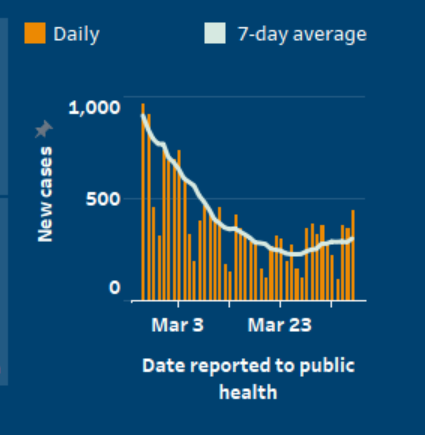
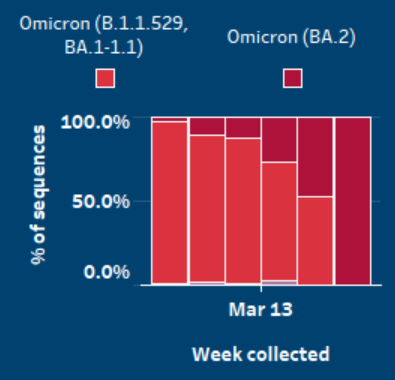 OHA Weekly Report: Big Jump in New Cases
For now, this will be the last of OHA’s weekly data and outbreak reports. Starting this week, OHA will publish the COVID-19 data and outbreak reports every other Wednesday, consistent with the new reporting schedule they shared last week. I’ll continue to provide you with high-level information that can let us know where we appear to be headed here in Oregon.
This COVID-19 Weekly Data Report, released yesterday, shows an increase in weekly cases, a continued decline in disease-related hospitalizations and an increase in deaths.
- OHA reported 1,988 new cases of COVID-19 during the week of March 28 through April 3, a 42% increase over the previous week. This reverses a nine-week streak of declines. As you’ll see below, this increase is at least in part due to an uptick in testing and a slight increase in the test positivity rate.
- There were 97 COVID-19-related hospitalizations, a 44% decline over the previous week. This marked the first week that fewer than 100 hospitalizations were reported since the week of June 28 to July 4, 2021.
- There were 140 COVID-19-related deaths, up from 99 the previous week.
- Reported COVID-19 test results increased by 16%. There were 78,387 tests administered, vs. 67,504 last week.
- Test positivity again increased slightly, from 2.7% to 2.9%.
Wednesday’s COVID-19 Weekly Outbreak Report shows 50 total active outbreaks in care facilities, senior living communities and congregate living settings. This is another decline from last week’s 67 (and 98 the week before). OHA reported 26 COVID deaths for residents in congregate care for a total of 2247. This is a smaller number than last week’s 35 (for a total of 2221 last week).
Weekly County Report: Continuing Increases in Test Positivity Rates
OHA is no longer providing a weekly county report each Monday. However, you can track the test positivity rates for each county and the state as a whole at this dashboard.
The test positivity rates reported this week remain at low levels, but it is going up.
The statewide infection rate has gone from 2.7% last week to 3.4% this week. This is still low but something to watch.
Multnomah County is a little below the state average, at 3.2%, up from 2.8% last week.
OHA Updates Its Wastewater Monitoring Site
Thanks to ongoing wastewater monitoring, OHA is able to keep an eye on the presence of COVID in communities before it shows up in in individual tests. This is particularly important now that much our testing is occurring at home through private rapid tests.
OHA has a dashboard site that allows you to see the results around the state, with circles indicating whether the amount of COVID in a city is increasing, decreasing, or remaining steady.
The cities of Albany and Hillsboro are unfortunately showing sustained increases right now.
If you click on a city circle, you can get more information about the city, including the presence of COVID in the city’s wastewater over time.
You can check it out here.
Additional COVID Updates and Links
- FDA advisors met yesterday to start working on a long-term plan for COVID vaccine boosters.
- Here’s what the CDC Director has to say about who needs a second booster.
- Here’s reporting on the mixed results in a recent study of the effectiveness of a fourth dose.
- And here are the details of that Israeli study, as it appeared in The New England Journal of Medicine.
- Monica Gandhi and Michael Daignault argue that we need to have a long-term, comprehensive booster strategy.
- The New York Times’ David Leonhardt wonders why we're not seeing as many new cases as Europe is.
- Nevertheless, an article in today’s New York Times, notes that cases are slowly rising in New York, and wonders, should New Yorkers be worried?
- The White House has announced a new way for those on Medicare and Medicare Advantage to get over-the-counter COVID tests for free.
- And the White House has rolled out a new plan to fight Long COVID.
-
More on the Omicron BA.2 variant from The Daily Beast.
- And now there this one, the recombinant Omicron XE variant.
- Nationwide, COVID nursing home deaths now appear to be at pandemic lows.
- An infectious disease doctor explains why he and his professional colleagues can't just "move on" from COVID.
- From the New York Times, here are seven things you can do to prepare for a potential COVID wave and lower your risk.
-
The New Yorker asks, "What Do We Do About COVID Now?"
- And from VOX, we need to be focusing on developing new vaccines NOW.
- And from The Atlantic, is BA.2 going to be our first "So What?" surge?
- Here’s an interesting feature from Nature about why it took so long for the WHO to acknowledge that COVID is an airborne disease.
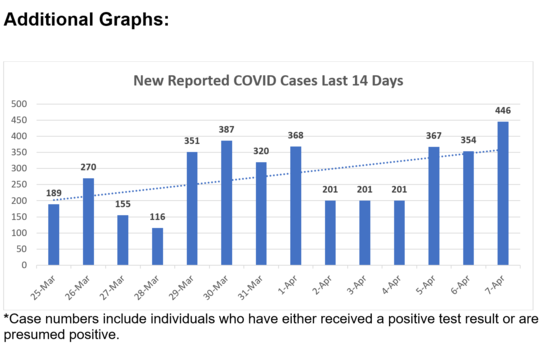
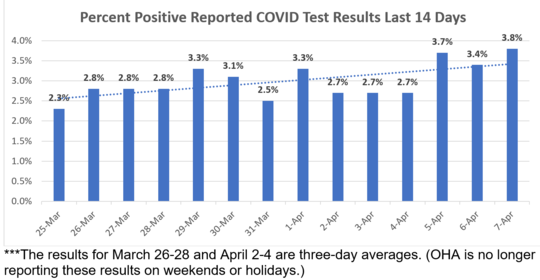

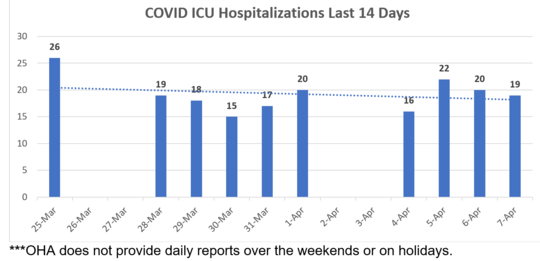
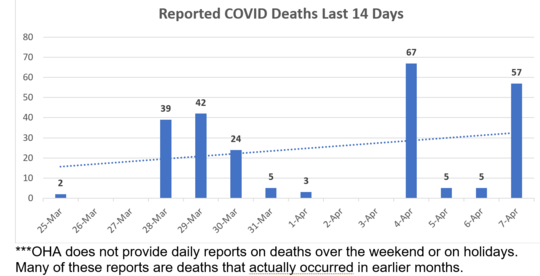
The following graph from OHA will show you the number of COVID deaths as they actually occurred (rather than when they were reported). It is of course always subject to change as additional deaths are reported.
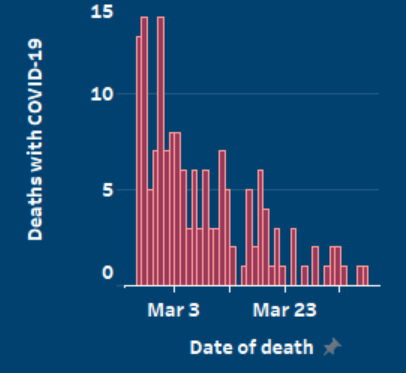
Here again are some COVID resources that you will find useful
If the above links are not providing you with answers to your questions or directing you to the help that you need, please consider me and my office to be a resource. We’ll do our best to assist you or steer you in the right direction.
Want to See Past Newsletters?
If there was COVID-related information in a past newsletter that you want to go back to, but find you’ve deleted it, you can always go to my legislative website (senatordembrow.com), click on “News and Information,” and you’ll find them all there. Also, if someone forwarded you this newsletter and you’d like to get it directly, you can sign up for it there.
Best,
 Senator Michael Dembrow
District 23
email: Sen.MichaelDembrow@oregonlegislature.gov
web: www.senatordembrow.com
phone: 503-281-0608
mail: 900 Court St NE, S-407, Salem, OR, 97301
|